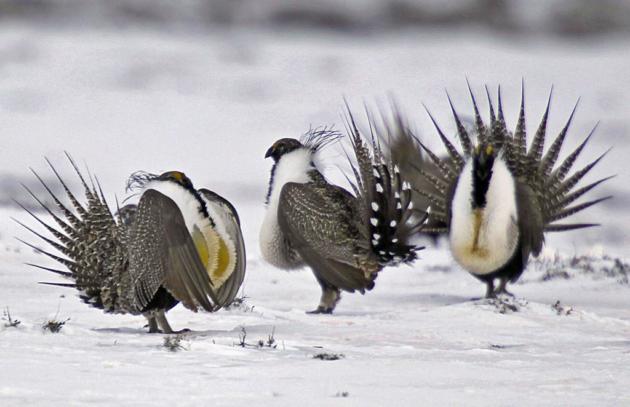Some governors in the US West say a new directive by the administration of President Donald Trump threatens to undermine a hard-won compromise aimed at saving a beleaguered bird scattered across their region.
The directive, issued in late July, severely limits a type of land swap involving federal property. Critics say that eliminates an important technique for saving habitat for the shrinking population of greater sage grouse, AP reported.
“It took one of our tools out of the toolbox,” said John Swartout, an adviser to Colorado Gov. John Hickenlooper.
Hickenlooper told federal officials in an Aug. 2 letter that he opposes the change. Nevada, Oregon and Utah also expressed opposition or concern. A spokeswoman for the US Bureau of Land Management, which issued the directive, said the agency would work with the governors on “adjusted” plans.
Greater sage grouse are spiky-tailed, ground-dwelling birds about the size of chickens. They are best known for the males’ showy displays in springtime mating dances.
Shrinking Population
They once numbered in the millions, but the US Fish and Wildlife Service now estimates the population at 200,000 to 500,000. Experts blame energy development that broke up the bird’s habitat, along with disease, livestock grazing and other causes. Their range covers about 699,300 square kilometers in parts of 11 Western US states and two Canadian provinces. The largest concentrations are in Wyoming, Montana, Nevada and Idaho.
In 2010, the Obama administration said the bird would need protection under the Endangered Species Act, which would have brought restrictions on drilling, mining, ranching and other development. But in 2015, the administration reversed course, announcing an intricate agreement called the Sage Grouse Initiative that relied on federal agencies, states, ranchers and others to save the bird without invoking potentially stricter limits under the endangered species law.
One tool states planned to use was requiring developers — such as energy companies drilling for oil — to replace destroyed or damaged habitat with similar land elsewhere. The practice is called “off-site compensatory mitigation” and is envisioned as a last resort, if the damage cannot be avoided or minimized.
But the Bureau of Land Management, which oversees about 1 million square kilometers of public land, announced on July 24 that it would no longer use mandatory off-site compensatory mitigation on most federal land. Some state officials and environmental groups worry that the government’s decision to back away from the mitigation tool could weaken the Sage Grouse Initiative and make it harder to save the bird.
“Right now, the compensatory mitigation requirements are a key tool,” said Nada Culver of The Wilderness Society. “Without them, there is no way to ensure we don’t keep losing sage grouse habitat.”


